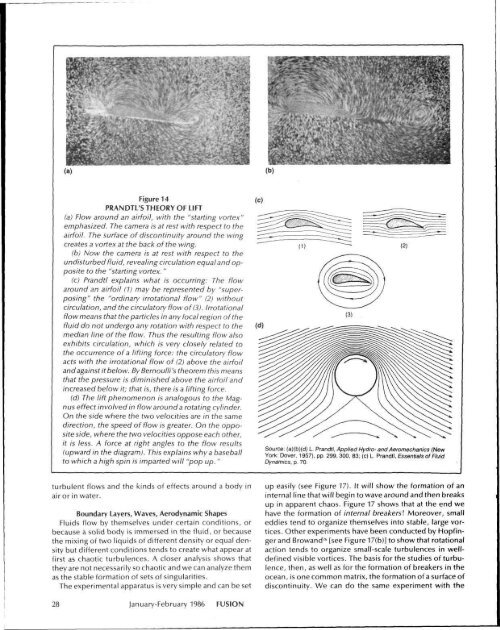And Hypersonic Flight
And Hypersonic Flight
And Hypersonic Flight
You also want an ePaper? Increase the reach of your titles
YUMPU automatically turns print PDFs into web optimized ePapers that Google loves.
(a)Figure 14PRANDTL'S THEORY OF LIFT(a) Flow around an airfoil, with the "starting vortex"emphasized. The camera is at rest with respect to theairfoil. The surface of discontinuity around the wingcreates a vortex at the back of the wing.(b) Now the camera is at rest with respect to theundisturbed fluid, revealing circulation equal and oppositeto the "starting vortex."(c) Prandtl explains what is occurring: The flowaround an airfoil (1) may be represented by "superposing"the "ordinary irrotational flow" (2) withoutcirculation, and the circulatory flow of (3). Irrotationalflow means that the particles in any local region of thefluid do not undergo any rotation with respect to themedian line of the flow. Thus the resulting flow alsoexhibits circulation, which is very closely related tothe occurrence of a lifting force: the circulatory flowacts with the irrotational flow of (2) above the airfoiland against it below. By Bernoulli's theorem this meansthat the pressure is diminished above the airfoil andincreased below it; that is, there is a lifting force.(d) The lift phenomenon is analogous to the Magnuseffect involved in flow around a rotating cylinder.On the side where the two velocities are in the samedirection, the speed of flow is greater. On the oppositeside, where the two velocities oppose each other,it is less. A force at right angles to the flow results(upward in the diagram). This explains why a baseballto which a high spin is imparted will "pop up."Source: (a)(b)(d) L. Prandtl, Applied Hydro- and Aeromechanics (NewYork: Dover, 1957), pp. 299, 300, 83; (c) L Prandtl, Essentials of FluidDynamics, p. 70.turbulent flows and the kinds of effects around a body inair or in water.Boundary Layers, Waves, Aerodynamic ShapesFluids flow by themselves under certain conditions, orbecause a solid body is immersed in the fluid, or becausethe mixing of two liquids of different density or equal densitybut different conditions tends to create what appear atfirst as chaotic turbulences. A closer analysis shows thatthey are not necessarily so chaotic and we can analyze themas the stable formation of sets of singularities.The experimental apparatus is very simple and can besetup easily (see Figure 17). It will show the formation of aninternal line that will begin to wave around and then breaksup in apparent chaos. Figure 17 shows that at the end wehave the formation of internal breakers'. Moreover, smalleddies tend to organize themselves into stable, large vortices.Other experiments have been conducted by Hopfingerand Browand 26 [see Figure 17(b)] to show that rotationalaction tends to organize small-scale turbulences in welldefinedvisible vortices. The basis for the studies of turbulence,then, as well as for the formation of breakers in theocean, is one common matrix, the formation of a surface ofdiscontinuity. We can do the same experiment with the28 January-February 1986 FUSION
















